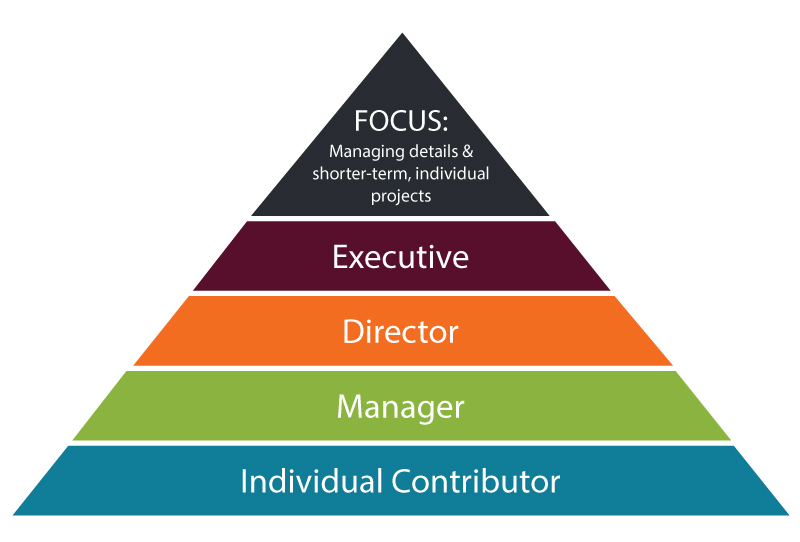A recent Forbes article, 5 Required Skills For Leading Change, made a big impact on Corporate Path Leadership. The synopsis was that Senior Leaders need to be skilled at leading change efforts, or at least seen as experts in change. Yet, normally there isn’t usually a formal training to acquire these skills.
It could be argued that the problem starts at the management level, where often times new managers are put in place without being trained on what is important behavior to adopt as a manager, and what behavior should be left behind as an individual contributor. Likewise, a supervisor or manager would need to leave certain behaviors behind and acquire new ones as they transition to a director or executive role. If left unaided, an executive focused on the details and day-to-day tasks like in their old role, may struggle to lead those change initiatives or think about the long-term goals every company needs as part of their new role.
At Corporate Path Leadership, we believe that there are two different pyramids that can be applied to employees — one with a wide base, and one that is inverted with a wide top. Using them together helps you realize areas where you need to focus, and that could shift – depending on your role, the organization and even the end goal. Think about how your leadership style might fit under one of these examples. Maybe you need to put more focus on one area, and less in another.
Wide Base Pyramid
The wide base pyramid represents more time spent managing the details of shorter-term individual projects and less time spent on driving long-term change and strategy, or motivating other people and teams.
This example shows time spent on managing details and working on shorter-term individual projects is the focus.
Short Base Pyramid
The short base pyramid shifts the focus to thinking of the overall company needs and creating a realistic vision and strategy. Managing daily activities, initiatives and programs are all left to the individuals and managers on the team.
This example shows time spent on teams and long term-initiatives is the focus.
How do we transition leaders from a manager to a director, or from a director to an executive?
As employees move from an individual contributor role to a manager role for the first time, the team needs to work with the employee to help them let go of some of the details of individual projects. It is now more important for the manager to oversee their direct reports and help them become successful at completing projects. This may include providing suggestions for moving a project along, but should not require the manager to do all the tasks to complete a project.
Similarly, when someone becomes an Executive for the first time, it can be daunting to let go of managing teams on a more daily basis or to stop actively managing initiatives and programs. This is especially the case if the team keeps pulling the person back to their old role to handle a situation. Teams need to help that person transition into the new role by limiting distractions, and assuring them that team has the day-to-day focus covered. This will enable the new executive to instead be thinking of the overall strategic needs of the company, and how they can create a realistic vision that the directors and managers can follow.
We advise those moving into a new role to consider the following four tips when transitioning into a leadership role:
#1 – FIND A COACH
It is never too late to work with a coach! Having monthly or even weekly contact with someone who can help guide you and listen to your needs as you approach a new level in the organization can be extremely valuable. A strong coach can help you identify blind spot areas that might be more pronounced as someone moves up the corporate ladder. They can also point out strengths and behaviors that should be leveraged when working with others.
#2 – FIND A LEARNING OR WORKSHOP OPPORTUNITY
There are many week-long training opportunities perfectly suited to map to specific leadership skills sets. For example, maybe setting corporate strategy is an area of weakness or interest for you. Choose a workshop focused on honing these skills. Or maybe you need to be a better financial thinker (even if your role is not related to finance directly). Take stock of your skills and areas where you think you need a boost, and then look for executive training options in that area.
#3 – ASK YOUR COMPANY FOR SUPPORT
Most companies will understand that your success is tied to theirs. As you evolve your skillset, your company will benefit. As such, ask them for support. Outline your commitment, the goals you want to reach and how you will apply these new skills to your new role. At a minimum, you will attract allies and team members willing to help you get there. You may also find they would be willing to pay for training or coaching that will help you succeed. So don’t be shy in asking for this commitment from them.
#4 COACH OTHERS
If you are in charge of a team or someone who is moving into a new role, make sure to stop and consider what type of coaching or training you can suggest to this employee to show your commitment to their future. Just like you would do for yourself, highlight their strengths, but also recommend behaviors that need to evolve or skills that could use a boost for them to succeed in the new role. It will help them and their coach succeed. Plus, it can help round out the individual coaching you would organically provide them.
Contact Us Today
We make it easy to jump start success. Simply contact us and share your current team challenge or need, and we’ll respond with program ideas to innovate your team performance.



